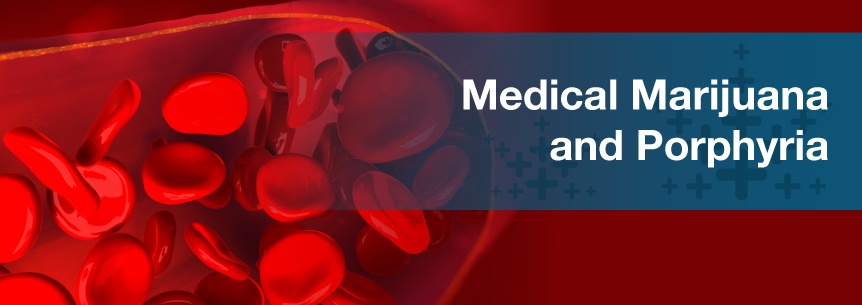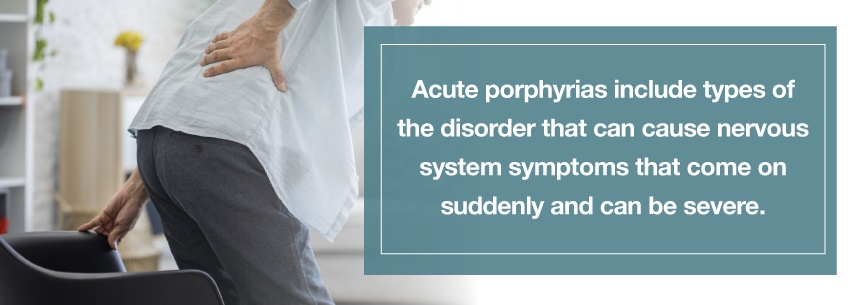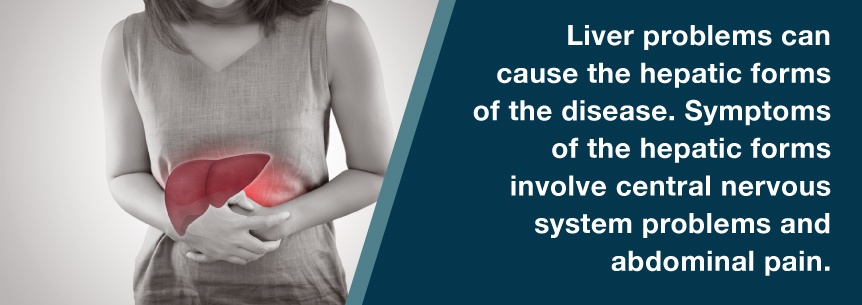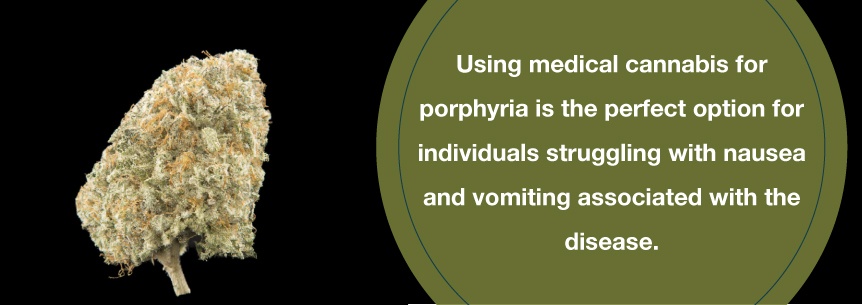
Whether you just received a new porphyria diagnosis or you’ve been struggling with the condition for years, it can be hard to deal with. No matter how severe your case, the symptoms of porphyria can make simple activities feel like unconquerable tasks. Fortunately, medical marijuana for porphyria can help.
Porphyria is a rare disorder that primarily affects the nervous system or skin and can also cause abdominal pain. Patients usually inherit the disorder because parents pass the gene abnormalities to their children. When an individual has the condition, their cells fail to change the chemicals porphyrin and porphyrins precursors in their body into heme — a substance that makes blood red.
The body creates heme mostly in the liver and bone marrow. Bone marrow is the sponge-like, soft tissue inside your bones which makes stem cells that turn into one of the three forms of blood cells: white blood cells, red blood cells and platelets.
The heme biosynthetic pathway is the process of making heme. Eight enzymes control each step in the process. If any of the enzymes are at a low level, the body will have issues making heme. This is known as a deficiency. Porphyrin and porphyrins heme precursors start building up in the body, causing illness.
Porphyria symptoms may vary in how severe they are, as well as by type and among people. Some individuals who have gene mutations causing porphyria don’t ever have any symptoms.
Acute porphyrias include types of the disorder that can cause nervous system symptoms that come on suddenly and can be severe. Symptoms can last a few days to several weeks and generally improve gradually after an attack. The common type of acute porphyria is intermittent porphyria.

Symptoms and signs of acute porphyria might include:
Cutaneous porphyrias include types of the condition that cause symptoms of the skin due to sunlight sensitivity, but they don’t typically affect your nervous system. The most common form of all porphyrias is porphyria cutanea tarda (PCT).
Because of being exposed to the sun, you could experience:
Many symptoms and signs of porphyria mimic those of other common conditions, making it hard to know if you’re experiencing a porphyria attack. Seek medical help if you experience any of these symptoms above.
Each form of porphyria comes with the same cause — a heme production problem. Heme is a hemoglobin component, a protein in the red blood cells that transfer oxygen to the entire body from the lungs.
Heme provides blood with its red color, and it contains iron. Heme production occurs in the bone marrow and liver and involves various distinct enzymes. When there’s a shortage of any of these enzymes, it creates an excess buildup of specific chemical compounds associated with the production of heme. The lack of enzyme will determine the specific type of porphyria.
You inherit most forms of porphyria. Most porphyrias occur when just one parent passes along an altered gene. The specific type will determine the risk of porphyria development or if you pass it to your children.
PCT, on the other hand, is typically an acquired condition. While you can inherit the enzyme deficiency that leads to PCT, most individuals that do inherit it don’t experience symptoms. Instead, the disorder becomes active when a certain lifestyle choice or condition triggers the deficiency.
These include:
Acute porphyria episodes, which hardly ever occur before puberty, could become triggered by certain drugs, including:
Other possible triggers are:
There are various types of porphyria, but you can classify them into two categories:

Hepatic porphyria has five types:
The most common type is PCT.
The form of porphyria you have determines the potential complications you could experience. If not treated promptly, acute porphyrias can threaten your life. While you’re having an attack, you could experience:
Episodes of acute porphyrias often require treatment at a hospital. There could be long-term physical effects, as well, with recurrent acute attacks that include chronic kidney failure, chronic pain and chronic liver damage.
Cutaneous porphyrias can cause permanent skin damage. Additionally, the skin blisters may become infected. After cutaneous porphyria, your skin could have an abnormal coloring and appearance once it heals. You may also have scars and fragile skin.
One study evaluating self-rated psychosocial components in individuals with acute porphyria found anxiety (mostly) and depression is more common in individuals with porphyria than in the general population. Almost half (46 percent) of the study’s subjects reported some issues with anxiety and/or depression, with 26 percent experiencing anxiety and 13 percent experiencing depression.
Facts surrounding porphyria from the American Porphyria Foundation include:

The “porphyrin” term, back in 1841, came from the Greek term “porphyrus,” which meant reddish-purple. Scientists first believed the blood’s reddish color was from iron. One scientist conducted an experiment to show this wasn’t the case. He used concentrated sulfuric acid to wash the dried blood and free the iron. Then, he used alcohol to treat it, and the iron-free residue that resulted appeared with a reddish-purple color even though no iron compound was in it.
Gerardus Johannes Mulder, in 1844, determined the iron-free, purplish substance’s chemical composition and named it “hematin.”
The treatment for porphyria depends on what type you have and the severity of your symptoms. Treatment usually involves identifying the signs and avoiding their triggers and if symptoms do occur, relieving them.
Avoiding triggers could include:
Acute porphyria treatment focuses on relieving symptoms quickly and preventing complications. Treatments could include:
Cutaneous Porphyria treatment focuses on minimizing triggers like sunlight exposure and reducing the body’s amount of porphyrins to help relieve your symptoms. This could include:
Side effects of these medications may include:
There have been recent advances in understanding the molecular genetic heterogeneity and pathogenesis of “hepatic cutaneous,” “acute hepatic” and “erythropoietic cutaneous” diseases. These advances, including DNA-based diagnoses, have resulted in an improvement in diagnosing and treating the diseases.
More than 40 clinical trials are identified to study porphyria.
Using medical cannabis for porphyria is the perfect option for individuals struggling with nausea and vomiting associated with the disease.

While certain medications are used to treat the disorder’s underlying causes, they can cause highly uncomfortable symptoms like nausea and vomiting. Also, opiates are often prescribed for pain but can be addictive and less effective over time. Cannabis can address both of these issues. It’s a natural anti-anxiety treatment that isn’t highly addictive as opiates, is compatible with other drugs that are usually incompatible and only causes a low risk of side effects.
Medications like analgesics, metabolized by cytochrome P450 (CYP), could induce acute attacks in individuals with hepatic porphyrias. Recently, a study suggests cannabinoid pharmaceutical preparations could help with treating pain. The study’s purpose was to evaluate the effects of a cannabinoid CB1 receptor agonist, CP-55,940, on the hepatic heme metabolism of mice.
The study’s results showed CP-55,940 treatment reduced CYP concentrations by 80 percent and resulted in a 158 percent increase in HO activity.
This indicates CP-55,940 as well as its metabolites don’t behave like porphyrinogenic medications and could be a safe alternative pain treatment in individuals with acute porphyrias.
Some symptoms marijuana for porphyria can help treat include:
Cannabis offers the benefits of being cultivated professionally for a consistent product. You’ll find many different variations in medical marijuana, and porphyria strains available and commercial growers are now able to produce plants and strains more accurately with the right chemical compound balance. Ideal strains based on your symptoms are as follows:
Here are some methods you can try to receive your cannabis treatment:
While smoking weed historically was the most common way of using cannabis for both medical and recreational users, it, like smoking tobacco, produces toxins and tar you inhale along with the herb. Therefore, it is not the most recommended way to consume your medical cannabis.
At MarijuanaDoctors.com, our goal is to provide you with the essential information you need to make an informed decision if medical cannabis is right for you. Your first step is to get familiar with your state’s laws on medical weed.
Then, you can use our directory to find a qualified cannabis doctor and dispensary to begin your medical marijuana for porphyria treatment plan. They can help provide you with the proper knowledge of the different cannabis products you’ll come across and design a treatment plan specific to your symptoms. Book your appointment today so you can finally start experiencing the relief.
Find A Doctor Find A Dispensary